#italian retail design
Text




Gucci SoHo Store Reopened With a Revamp - read more
1 note
·
View note
Photo

Before the Babble learning method, there was the Neiman-Marcus method.
#babble#neiman marcus#vintage graphic design#retailers#luxury brands#learn italian#learn a new language
1 note
·
View note
Text
A horror trope that I very much enjoy is the "haunted book" -- a book that affects the reader in some way, like the Necronomicon driving people mad, or Dr. Mabuse's book that hypnotizes its reader into doing his bidding. It recently had a nice moment in the Magnus Archives, with the Leitner subplot, and there's even a hint of it in Frankenstein, when Victor reads the work of a scientist that his professors dismiss as nonsense and becomes obsessively deranged studying the subject matter.
So it's not that I think it's time for a revival and lord knows the word "reboot" has begun to stink of soulless profit (I think we're one, maybe two flops from a reboot of the MCU). I'm not the most current on horror media in any case so maybe it's been done, but if not I do think we oughta start considering the idea of a haunted phone app.
Apps are already designed for this, anyway. In our current era, a lot of retail "apps" are just reskinned browsers that load an optimized version of the company's website, and the goal of most apps and websites is to keep you in the app/website. (Which is why the google mail and tumblr apps both have internal web browsers.) A lot of phone games are designed to keep you in the game and continually redirect you towards microtransactions, and even apps that aren't games often gamify use; "gamification" has come to be a polite euphemism for "creating addictive circumstances".
Alongside this, a lot of recent cults and cultlike organizations have determined that straight religion is not the best way in anymore, and are coming in sidelong through MLMs (Nexium), wellness and dietary orthodoxies (Bikram Yoga, a number of insta/tiktok orthorexia gurus), or political movements (Qanon). So you get a cult, set up like a business, with an app you use for your business -- or even a cult with a "wellness" app that monitors your sleep, eating, location (wait, that's just FitBit) -- and slowly it gamifies you right into attempting to raise a Great Old One using the power of your downstream or a nice big helping of olive oil coffee.
Although I hate those thinkpieces/art pieces that are all about "you're so busy on your phone you can't appreciate the world around you, remember when we read real paper books" so I would require that the protagonist defeat the evil also using a phone app, or at the very least blind the evil using the flashlight function. Locking the book away in a library app and then putting the phone on airplane mode is a nice resolution, followed perhaps by it lighting up even though it's offline with a message "someone is attempting to locate this phone" as the post-credits stinger for the sequel.
This thought brought to you by Duolingo, which recently fed me, in succession, the task of translating from Italian the phrases
Who do you see in the mirror?
We open the curtains and see the light.
The pillows and blankets are red.
809 notes
·
View notes
Text
The telling hashtag
So S is willfully disclosing his LHR location, with a story and a post to boot, as expected:
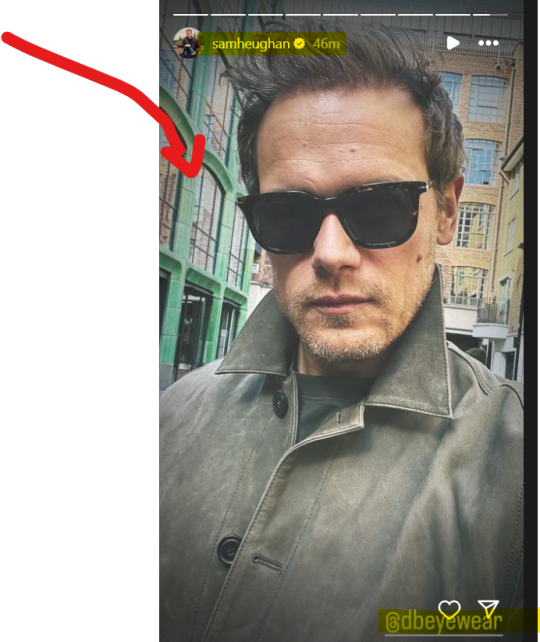
📌at Bourne Offices, 11 Richmond Buildings, in Soho:
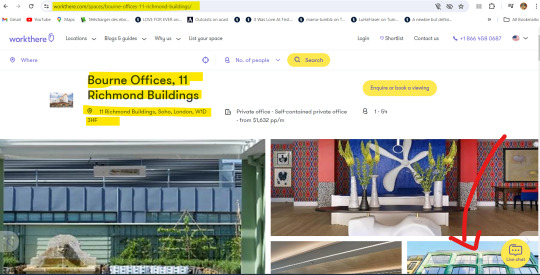
Literally round the corner from Soho House, on Dean Street. Of course:

Also, this - very telling:

#gifted. Before *urv starts her demented Fitness at Dawn - The London Hyrox Edition fanfic, let's unpack:
S chose to wear, in this post, one of the sunglasses models from David Beckham's eyewear collection. Price tag is a bit steep (twice my Ray-Ban Wayfarers), but still democratic:
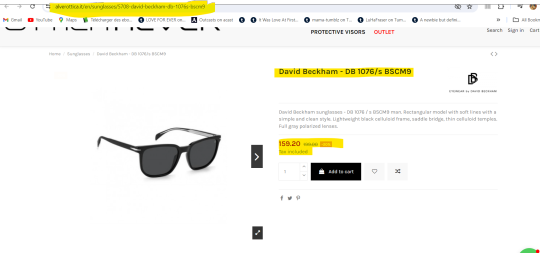
But why the #gifted hashtag? Before you think C or Scottish Xena lovingly picked those up the shelf for his birthday, you might like to check a bit around for context. You see, all dbeyewear collections are manufactured by a single Italian producer based in Padua, Safilo Group. Hashtagged accordingly in his post, by the way.
A couple of days ago, Safilo Group and dbeyewear's commercial partnership reached a new, very important milestone:
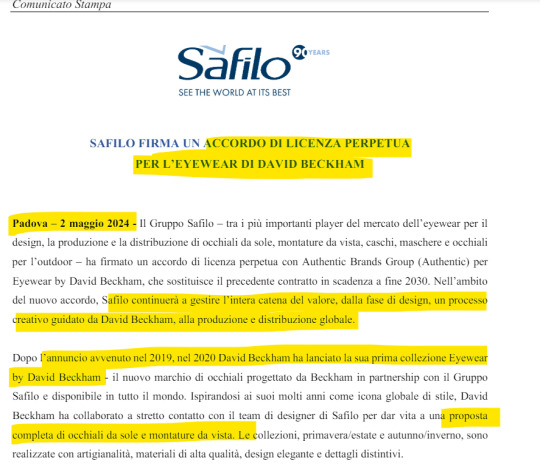
[Source: Safilo Group press release, https://assets.ctfassets.net/cmstik7jzbvm/2lwJmoKJR7x3ydijfpi7c6/9870e11fbb2c040a89a6d8acb4ed25ea/20240502_Safilo_firma_un_accordo_di_licenza_perpetua_per_l-eyewear_di_David_Beckham.pdf]
On May 2nd, Safilo Group and Authentic Brands Group (ABG), the corporate side of Eyewear by David Beckham signed a 'perpetual licensing agreement, replacing the current one that would have ended in 2030'. Authentic Brands Group and Safilo Group have been working together since 2019, when Beckham started to design his own eyewear collection. Now, they are taking their collaboration one step further, with ABG (or the licensor) granting Safilo Group (the licensee) perpetual (unlikely to be retired, unless something goes really, awfully wrong along the way: breach of contract, etc.) exclusive right to produce, use, advertise, sell its merchandise.
Something like this needs proper promotion, so Safilo Group and/or ABG graciously sent S those sunglasses, in the hope he will sport them in one of his posts with a potential 3+ million subscriber views.
A word on the UK pretty obscure regulations on promoter advertising and the use of the #gifted hashtag. There is not one, but two competent national regulatory authorities: the Advertising Standards Authority (ASA) and the Competition and Markets Authority (CMA). The ASA is a bit more lenient in its approach and they clearly say that if the promoted product has been sent to the influencer on a no strings attached basis, then it is ok to use that #gifted hashtag. They will not pursue, based on the lack of #ad, however they will name and shame you - not a pretty picture, after all:
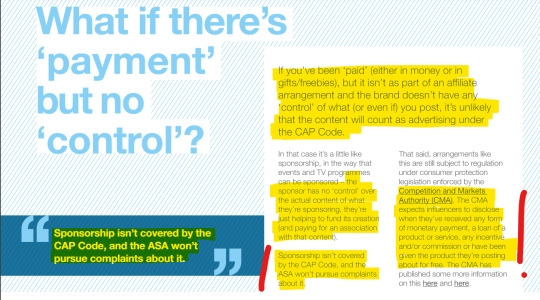
[Source, heh: ASA's Influencer Guide to making clear that ads are ads, https://www.asa.org.uk/static/uploaded/3af39c72-76e1-4a59-b2b47e81a034cd1d.pdf]
But the CMA is way more vigilant. They consider that any freebie can and must be monetized, based on its retail value and as such, must be clearly labeled as an #ad, when promoted on socials by an influencer. And yes, they can and might pursue, at any given moment: that must be proportional with the offence and in S's case, it might simply mean being served with a cease and desist notice or a removal and prohibition order. I'd rather not be in those shoes, mind you:


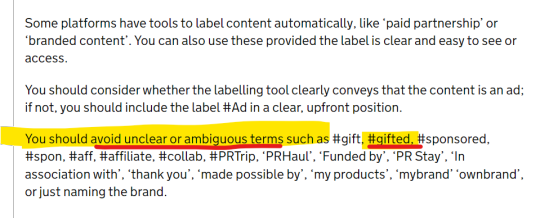

[Source: CMA's guide Hidden ads: Being clear with your audience, 2022; https://www.gov.uk/government/publications/social-media-endorsements-guide-for-influencers/social-media-endorsements-being-transparent-with-your-followers]
If he wants no further headaches, he should simply edit that post and add the right hashtag. It will be interesting to see if and when he will do it.
As for Fitness at Dawn, well... not even sorry.
Gracias a ti, ❤️. Siempre.
73 notes
·
View notes
Text
FLORENCE, Italy – As Steven Stokey-Daley’s fall show in Florence during Pitti Uomo wrapped, the British designer, the 2022 recipient of the LVMH Prize for Young Designers, revealed longtime fan Harry Styles is acquiring a minority stake in the company.
Financial terms of the deal were not disclosed.
“Harry and I have a shared vision for the future of S.S. Daley and we look forward to this new chapter together as we focus on brand longevity and scaling the business into a modern British heritage house,” the designer, 26, said.
The pair was introduced by Styles’ stylist Harry Lambert, who masterminded the wardrobe for the artist’s “Golden” music video, outfitting him in Stokey-Daley’s graduate collection.
The investment is geared at building S.S. Daley’s direct-to-consumer business and forge ahead with plans for a “sustainable and long-term expansion,” the company said in a statement.
After graduating from the University of Westminster, Stokey-Daley made his London Fashion Week debut in September 2021 supported by the National Youth Theatre artistic director Paul Roseby, staging a four-part performance by members of the theater, riffing on British tailoring and tackling such topics as social class, inequality, school life, sexual awakening and homosexuality.
That same year, the S.S. Daley designer was among the recipients of the British Fashion Council’s Newgen initiative and was awarded again by the British fashion governing body the following year, with the BFC Foundation Awards.
The designer’s gender-fluid take on the uniforms of the British upper classes, such as wide-leg trousers, argyle-knit wool vests and embroidered shirts, appeals to a Gen-Z sensibility, and a growing female customer base. The brand is currently stocked in a handful of retailers, including Saks Fifth Avenue, Dover Street Market, Matchesfashion, Bergdorf Goodman, 10 Corso Como Seoul and I.T Store.
Attending the S.S. Daley show in Florence, Sir Paul Smith praised Stokey-Daley and said: “I think that the ideal thing [for him] would be to try and work in parallel with a commercial company that help him develop as a commercial designer, as well as creative designer. And of course, that’s what everybody dreams of. He has the balance between commerciality and creativity.”
“I think [his designs] might have had similarities in my earlier [career]… We are in 60-something countries now. So you have to be a lot more aware of commerciality and things that work for the shops especially right now because the business and around the world is so difficult for people,” Smith added.
Styles’ investment falls in line with a growing number of celebrities becoming brand shareholders. They include, among others, Oprah Winfrey and Reese Witherspoon who invested in Spanx; Priyanka Chopra and Nick Jonas in skiwear maker Perfect Moment; Beyoncé, Jessica Alba and Rihanna in French accessories firm Destree; Mila Kunis, Cameron Diaz and Gabrielle Union in Autumn Adeigbo, and Mark Wahlberg in Italian sneaker brand P448.
79 notes
·
View notes
Text
Some period pants sold by high street retailers contain high levels of silver that could have health and environmental implications for consumers, an investigation has found.
Silver is used as an antimicrobial agent and is typically added to period pants to combat user concerns about smell and hygiene.
However, scientists have increasingly warned about the potential health effects. The US Food and Drug Administration found that nanosilver can kill lactobacillus, the healthy bacteria in the vagina that help fight off infection. This can put period pant users more at risk of harmful bacteria, potentially leading to an increased risk of bacterial infections and pregnancy complications.
Natalie Hitchins, the head of home products and services at Which?, said: “Consumers should be cautious buying period pants which contain silver as experts have concerns about the health implications.
“Which? believes brands should also clearly state which products contain silver so shoppers can make informed decisions about what they are buying and the possible risks.”
The consumer rights group worked with an Italian consumer organisation, Altroconsumo, to independently test popular brands and check if they contained any chemicals of concern. They were worried to find that some products contained significant levels of silver, and this was not always made clear on the packaging.
Intima by Bodyform and pants by Marks & Spencer in particular contained notably more silver than other brands, at 126.7mg/kg and 57.8mg/kg respectively. Other brands contained 8.3mg/kg, 7.4mg/kg, and 0.9mg/kg.
Essity, the owner of Bodyform and Modibodi, said silver copper zeolite was used to “prevent odour when wearing the pants for up to 12 hours”. It added that all of its “washable underwear is certified according to Oeko-Tex Standard 100, which means that every single component has been tested for harmful substances” and “that the underwear has been designated as harmless for human health”.
An M&S Spokesperson said: “We do not use either nano silver or silver zeolite and, like many brands, use a small amount of silver chloride in the middle part of the gusset – away from the skin – which is perfectly safe, approved by the UK and EU, and designed to combat odour.”
Which? said it believed the use of silver was unnecessary and that previous testing by Altroconsumo had shown that textile items treated in this way did not have the promised antimicrobial properties.
The European Chemicals Agency says silver treatments, such as nanosilver and silver zeolite, are toxic to aquatic life with long-lasting effects.
The tests Which? carried out can detect any silver above 0.1mg/kg, and it found none in Primark, Repeat, Wuka, Lovable and Sloggi pants. Sloggi’s website says it does use a silver-based antimicrobial, and Primark says it uses Micro-Fresh, which contains silver chloride.
A Primark spokesperson said: “The nature of period pants means there is a potential for odour to develop during wear (in the same way that bacteria can cause socks and shoes to develop odours during wear) and our antimicrobial finish minimises such odours.”
Sloggi did not reply to Which? at the time of publication.
There are no legal limits in the UK about how much silver can be added to period pants. Manufacturers do not have to declare the presence of silver on their packaging or website.
46 notes
·
View notes
Text
All of the Moschino References for Jr. High Amaya Raine (Plus: join me in finding out how much she paid for this outfit to wear to Junior High)
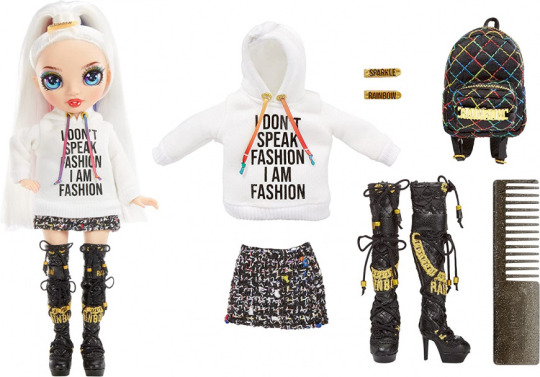
The sweatshirt is based on Jeremy Scott’s “I Don’t Speak Italian But I Do Speak Moschino” tee, which he wore to his debut runway when he became Moschino’s creative director in 2014. The phrase was supposed to reflect Moschino’s transition from being very elite and exclusive to one that was more accessible to the general public, especially young people.
Amaya’s hoodie combines the slogan with Coco Chanel’s famous quote (“I don’t do fashion I am fashion”). Cost: $180 USD


Her shoes are these thigh-high boots created for a collaboration with H&M. I think the doll-scale replica is my favorite part of this outfit. Cost: $100
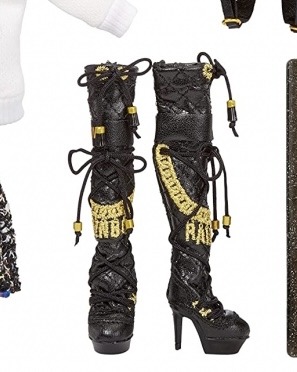
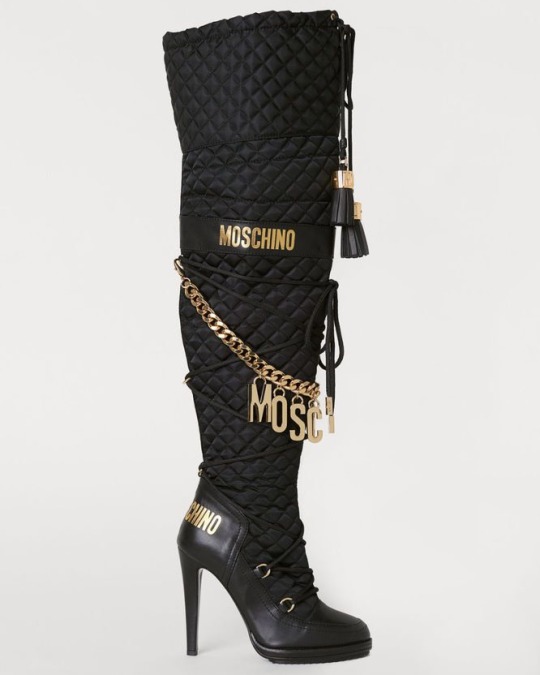
Her skirt I believe is this boucle miniskirt (boucle is a textile that’s like tweed made with softer material, a it tends to have a rougher, “messy” look.)


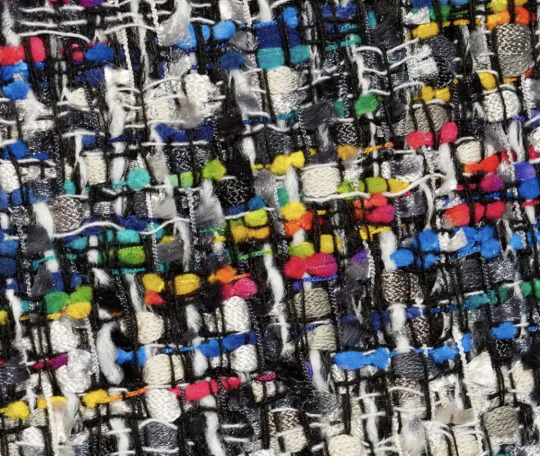
You can especially see the similarity when you look at the (real-life) skirt’s fabric up close. Pretty cool! And it better be, because it’s $450.
Her bag is this quilted logo backpack. This thing retails for $660 USD, why does a jr high student own this.

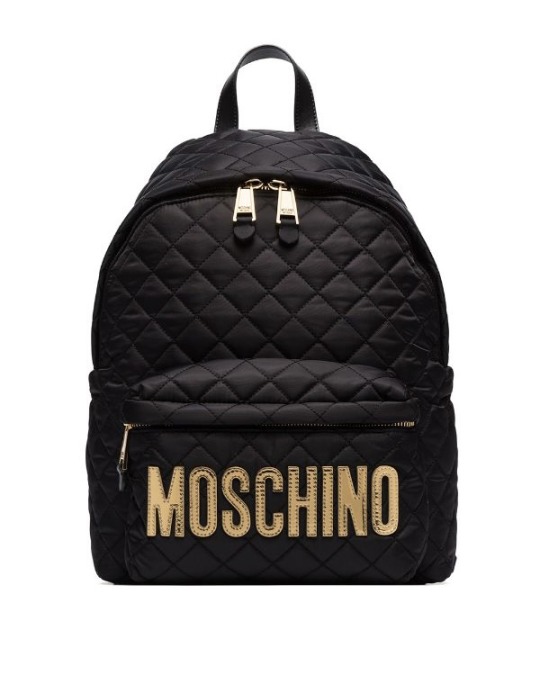
And she’s even got Moschino hair clips! ($400 worth of Moschino hair clips to be exact)

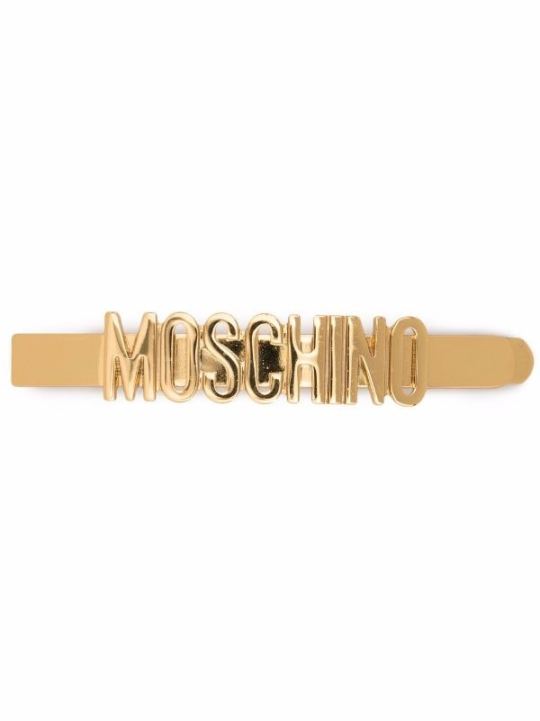
So this brings our total to an outfit cost of $1790! Join us next time to find out why a 13 year old is running around school in an eighteen-hundred dollar designer outfit for no reason.
#i literally find it so funny#i always start to like outfits more after I research them#like now I have a ~connection~ with the pieces#also holy hell this took me forever bc tumblr's post creator is going sicko mode#rainbow high#amaya raine#rainbow high jr high#rainbow high fashion references#rh amaya#dolls#fashion dolls#fashion#moschino#jeremy scott#doll collector#adult collector
403 notes
·
View notes
Text

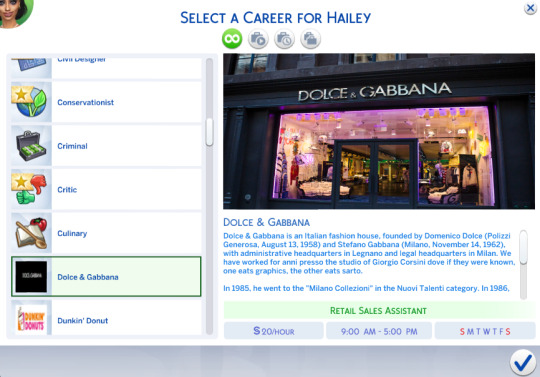



🦄The Sims🦄
👠High Brand Stores 2 Bundle👠
💕EARLY RELEASE 4.13.2024💕
GUCCI
Kering (previously PPR) is the French luxury goods holding company owner of Alexander McQueen, Balenciaga, Brioni, Gucci, Puma, Volcom, and other luxury, sport & lifestyle brands distributed in 120 countries. The company was founded in 1963 by businessman François Pinault and is now run by his son François-Henri Pinault.
Greeter
Team Coordinator
Talent Partner
Manager
Visual Merchandiser
Analyst
Allow Teen
Allow Young Adult
Allow Adult
Allow Elder
Balenciaga
Kering (previously PPR) is the French luxury goods holding company owner of Alexander McQueen, Balenciaga, Brioni, Gucci, Puma, Volcom, and other luxury, sport & lifestyle brands distributed in 120 countries. The company was founded in 1963 by businessman François Pinault and is now run by his son François-Henri Pinault.
Stock Manager
Sales Associate
Sales & Client Advisor
Buyer
Store Director
Allow Teen
Allow Young Adult
Allow Adult
Allow Elder
Dolce & Gabbana
Dolce & Gabbana is an Italian fashion house, founded by Domenico Dolce (Polizzi Generosa, August 13, 1958) and Stefano Gabbana (Milano, November 14, 1962), with administrative headquarters in Legnano and legal headquarters in Milan. We have worked for anni presso the studio of Giorgio Corsini dove if they were known, one eats graphics, the other eats sarto. In 1985, he went to the "Milano Collezioni" in the Nuovi Talenti category. In 1986, we presented the first autoprodotta collection, at the headquarters of the Milanese atelier and the first production. The production continues with the opening of a new business in Milan and Bari. In 1988 he signed the agreement with the area located in Legnano di Saverio Dolce (father of Domenico), for the production of ready-to-wear. In 1989, he left there, first of all, Donna went to Tokyo and created the first line of intimacy and marriage.
Retail Sales Assistant
Stock Keeper
Visual Merchandiser
Stock Supervisor
Assistant Store Manager
Store Manager
Sales Manager
Men's Wholesale Sr. Manager/Director
Allow Teen
Allow Young Adult
Allow Adult
Allow Elder
Louis Vuitton
Louis Vuitton est une maison française de maroquinerie de luxe, mais également de prêt-à-porter depuis l'aube des années 2000, fondée en 1854 par le malletier, plus tard maroquinier, Louis Vuitton (1821-1892) dont l'œuvre est poursuivie par ses descendants. Louis Vuitton Malletier est la première marque du groupe LVMH - Moët Hennessy Louis Vuitton fondé en 1987 par le rapprochement de la maroquinerie Vuitton et des Champagne Moët & Chandon, et propriété du milliardaire Bernard Arnault depuis 1989. Louis Vuitton a une présence mondiale, avec un fort développement vers l'Asie depuis les années 2000.
CLIENT ADVISOR
TEAM LEAD
CLIENT CARE ASSOCIATE
TEAM MANAGER
WATCH AMBASSADOR
ACCOUNTS PAYABLE ASSOCIATE
TAILOR
ASSISTANT STORE DIRECTOR
FASHION STYLIST
Allow Teen
Allow Young Adult
Allow Adult
Allow Elder
Prada
Pioneer of a dialogue with contemporary society across diverse cultural spheres and an influential leader in luxury fashion, Prada Group founds its identity on essential values such creative independence, transformation and sustainable development, offering its brands a shared vision to interpret and express their spirit. The Group owns some of the world’s most prestigious luxury brands, Prada, Miu Miu, Church’s, Car Shoe and the historic Pasticceria Marchesi, and works constantly to enhance their value by increasing their visibility and appeal. The Group designs, manufactures and distributes ready-to-wear collections, leather goods and footwear in more than 70 countries through a network of 633 stores as well as e-commerce channels, selected e-tailers and department stores around the world. The Group, which also operates in the eyewear and fragrances sector through licensing agreements, has 23 owned factories and approximately thirteen thousand employees.
Cashier
Stock Associate
Client Advisor
Sales Support
Runner
Department Manager
Stock Supervisor
Selling Supervisor
Allow Teen
Allow Young Adult
Allow Adult
Allow Elder
DOWNLOAD NOW
#gaming#the sims 4#the sims 4 cc#the sims university#celebrities#nicki minaj#the sims 4 mod#actors#clothes#Prada#Louis Vuitton#Dolce & Gabbana#Balenciaga#GUCCI#High Brand#cardi b#fypシ#fypage#tumblr fyp#text post#foryou#coachella#sexy#sexy tease#sexy content
17 notes
·
View notes
Text
From Viaggio (Italian for travel) collection designed by vegan brand LAVISHY established since 2001, this cool printed unisex key ring coin purse features vintage style illustration of elephant on the background of old map. It's fun, functional & fabulous. Made with Eco-friendly vegan materials that are toxic-free, recyclable and biodegradable. This unisex key ring coin purse is great for everyday use, travel as well as an unique gift for your friends and family.
Exterior: Vegan/faux leather
Interior: Nylon
- with key ring to carry keys
- 1 ID pocket at the back for driver's license or metro pass
- can hold credit cards
Measurement: 5 x 3.9 inch / 13 x 10 cm
Wholesale available at www.lavishy.com to wide ranges of retailers including independent brick-and-mortar gift shops, clothing & fashion accessories boutiques, book stores, hotel/resort & airport/ferries gift stores, museum & botanical garden gift shops, flower shops & garden centers, online boutiques, & specialty retailers in Canada, USA & the rest of the world since 2001.
Reasons for whey this unisex key ring coin purse is a wonderful lucky / good luck gift idea for your loved ones:
The elephant with its trunk raised is indeed considered a symbol of luck and good fortune in various cultures, especially in Eastern societies such as India and Thailand. Here's why:
Strength and Power: Elephants are known for their immense strength and power. In many cultures, they symbolize strength, stability, and resilience. When depicted with their trunks raised, they are seen as asserting their strength and overcoming obstacles, which is considered fortunate.
Wisdom and Intelligence: Elephants are highly intelligent creatures, known for their problem-solving skills and strong social bonds. Their association with wisdom and intelligence adds to the symbolism of luck. It's believed that having the trunk up signifies wisdom and foresight.
Good Luck: In some cultures, the elephant's trunk is seen as a conduit for good luck and positive energy. When the trunk is raised, it is believed to be gathering positive energy and spreading it around, bringing good fortune to those nearby.
Fertility and Prosperity: The elephant is also associated with fertility and prosperity. In Hinduism, the elephant-headed god Ganesha is worshipped as the remover of obstacles and the provider of prosperity. The raised trunk symbolizes fertility and abundance, making it a popular motif in Indian households and businesses.
Overall, the elephant with its trunk raised is considered a powerful symbol of luck, prosperity, wisdom, and protection in many cultures, making it a popular choice for decorative and symbolic purposes.
5 notes
·
View notes
Text
Disney Dreamland - Part 4: Fantasyland
(I had already posted about Mysteryland previously, which retroactively makes it Part 3. So we're moving on to the next part.)
Quite possibly the largest of the five lands, probably even beating out my mega-Adventureland.
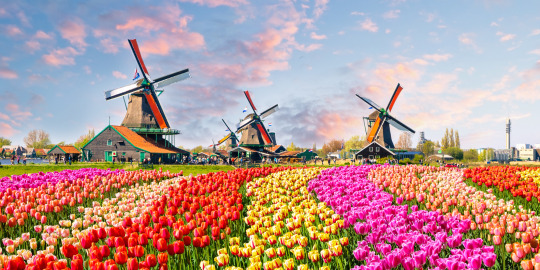
Small World Gardens
Located behind Small World, this sprawling area would transition into Storybook Town Square. Flower arrangements inspired by Keukenhof in the Netherlands. Similar to Paris’s Fantasyland, there would be a couple rivers running through the garden with lovely bridges to cross over them.
Dumbo the Flying Elephant : The Masquerade Circus could be positioned near the Mysteryland/Fantasyland border so that the back of the tents could serve as a backdrop for the Dumbo ride, which would have its own little area in the gardens. I was at a loss on where else to place this ride, but I stubbornly wanted to include it as it is currently the only attraction to be found in all 6 existing castle parks and I didn't want to break that streak.
"Casey Jr. Circus Train": Doesn't have to specifically be Dumbo-themed, I just really want a cute novelty train to wind through the garden, with cute bridges to pass over the walkways and rivers.
“Swan Boats”: Paddle boats. I say “swan boats” but they don’t have to be just swans, but could also resemble other birds such as ducks, geese, and flamingos.
Symphony Gazebo: A gazebo in the garden for a live band to play classical music.
“Windmill snack stand”: I saw a picture of the Old Mill in Paris and thought it looked so charming. German pretzels.

Storybook Town Square
The town follows in the footsteps of Ananheim’s 1983 overhaul with each building having its own unique look. Would feature a fluid mix of Bavarian and British architecture. The Bavarian half of the town on the west contains “Pinocchio Square” and the theater. The British half on the east contains Peter Pan, Little Nemo (even though Nemo is American), and Mr. Toad. A large fountain stands in the center. Cobblestones would pave the ground. I want this area to evoke the feeling of Paris’s Fantasyland as well as Efteling in the Netherlands .
Pinocchio’s Daring Escape: Focuses more on escaping Pleasure Island. The only other thing I would change is have all the sets and animatronics appear to be carved out of wood, and have real clothes on the animatronics, for a more high-quality “hand made” look, the implication being the entire ride is a life-sized puppet show.
The ride building along with the toy shop and restaurant form a smaller “Pinocchio Square”, which would include a smaller fountain with a statue of Pinocchio.
Geppetto’s Toy Shop: Would feature regular retail plush toys, as well as old fashioned toys like wooden marionettes and wind-ups, as well as cuckoo clocks. Christmas ornaments can also be purchased here.
Pinocchio’s Pizza Place: Italian cuisine. Basically the Pinocchio Village Haus in Orlando, but with an alliterative name, and also some of the pizzas have toppings decorated to look like Pinocchio smiley faces. Quick service.
Once Upon a Time Theatre: Hosts live indoor stage shows. While any show with Disney musical medleys is fine, I would much prefer original shows of rarely-featured stories, such as the other tales from the 1001 Arabian Nights, or a stage version of Disney's Return to Oz (which I personally love better as an Oz adaptation than MGM's movie; 2013's Oz the Great and Powerful was meh).
Building design would be modeled after the new Fantasyland Forest Theatre in Tokyo.
“German restaurant”: Table service.
Flight to Neverland: Would utilize the best aspects from each version of the ride. For example, I love that Shanghai’s queue is themed to a London park (Kensington Gardens?), and the chimneys in Paris’s loading dock blow smoke. The building facade would definitely have a functioning clock tower, in homage to Big Ben, but designed to fit with the small town aesthetic.
The name change is simply because I feel like guests actually take on the role of the Darling children more than they do Peter.
Little Nemo in Slumberland: Little Nemo may not be a Disney IP, but it has such rich and vibrant imagery, I think it could work really well as a Disney ride. Not to mention it’s in the public domain, so there shouldn’t be any legal issues. In many ways it’s very similar to Peter Pan’s Flight, so maybe it could also help balance the wait times between the two rides.
Guests take on the role of Nemo and ride flying beds (or at least, benches that look like beds, with a headboard and a footboard) that soar out the bedroom window. What follows are awe-inspiring, almost surreal, scenes of Slumberland. Things start to distort and become chaotic as the dream turns into a nightmare. Before anything too awful happens, guests “wake up” back in Nemo’s bedroom while the voice of Nemo’s mother scolds us for eating before bed. For visual reference, I recommend the Osamu Dezaki pilot film that was created during the movie’s development, though I obviously wouldn’t put the giant Sauron eye in the ride.
Mr. Toad’s Wild Ride: Orlando’s former double-track ride, but with Anaheim’s building exterior. I never got to experience this ride and I really want to.
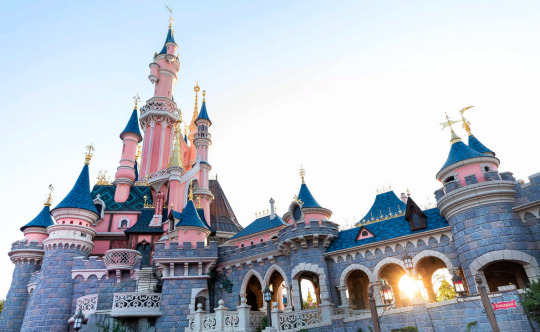
Ever After Castle
Here it is, the traditional centerpiece of all Disney parks, now the centerpiece of Fantasyland instead.
I personally think of most Disney castles as tall but not wide. This castle would be slightly different from the traditional Disney castle by taking up more ground space. I hate to sound blasphemous, but for this castle I’m thinking of something similar to Shrek’s Far Far Away Castle in Universal Singapore but with more detailed ornate decorations like Paris’ castle, and the outer walls slightly covered in ivy vines for a more inviting, homely look. It would also stand on top of an elevated foundation, surrounded by a moat.
There would be a large courtyard in front of the main castle building, with the carousel placed in the center of it. The gift shop and the meet-and-greet are each placed on either the west or east side of the courtyard. The north of the courtyard would feature the restaurant on the ground floor, the entrance to the underground boat ride, and stairs to the second floor attraction.
Cinderella’s Carriage Carrousel: Regarding the visual design, I want it to look like the pumpkin carriage turned into a carousel. The canopy could include fiber optic fairy dust that lights up at night.
Be Our Guest Restaurant: French cuisine. I really like Tokyo’s Beauty and the Beast ride and would love to import it, but I respect the OLC’s exclusivity rights too much. I wondered if I could make it a combination ride and restaurant where each table is a ride vehicle, but I worried that would cause motion sickness which is a big no-no for a restaurant.
At the very least, for my version I would love to have animatronics perform “Be Our Guest” every 30 minutes or so. Also, perhaps every hour, Belle and Beast performers would come out onto the dance floor and invite guests to waltz with them.
Hot Take: The Grey Stuff is very obviously a savory food as it is clearly presented on a tray of hors d'oeuvres in the movie. But since the version currently offered in the parks has been imprinted in fans’ minds I think it’s best to offer two versions: Savory (chicken liver pate) as an appetizer and Sweet (cookies and cream) as a dessert.
Royal Meet-and-Greet: I personally do not care much for meet and greets, but for the people that do, here you can meet the Princesses, some of the Princes, as well as non-Princesses such as Giselle, Esmeralda, and TinkerBell.
Kingdom Treasures gift shop: Based on the Tokyo shop of the same name.
Crystal Caverns Canal: Boat ride underneath the castle. My first idea for this ride was basically Voyage to the Crystal Grotto from Shanghai, if all the character statues were built out of crystals and mosaic tiles.
Then I realized, there’s probably too much IP already in the land, so I think there could be an original story about the crystals being a source of magic for the kingdom, and have scenes of wizards and fairies harvesting the crystals and creating experiments with them. Sort of a “tour of the workshop” kind of ride. I’m thinking of something with the same vibes as Dreamflight in Efteling.
Merlin’s Library / Yen Sid’s Library: Located on the second floor of the castle. Originally I wanted a ride in a similar vein to Symbolica in Efteling, but with a story like that of Mystic Manor in Hong Kong. Then I wondered if it would be feasible to have a ride in the second story, so I’m also okay with this being a walkthrough attraction.
I feel either wizard could work here. Merlin is the more well-known wizard, but Yen Sid is easier to create an original backstory for. The basic gist of the attraction is you wander around a library with little vignettes of magical items operating on their own; a quill pen writing by itself, a large spell book turning its own pages, floating books sorting themselves on the shelves, etc. There could even be some interactive elements, such as paintings that change, or opening a book can project a scene “coming to life” and “escaping” the book.
Fairytale Gardens: Walkthrough garden. There would be lovely little vignettes scattered throughout, including Snow White’s wishing well, a giant beanstalk, and The Sword in the Stone placed in a little alcove in the castle’s outer wall.
This would be outside the courtyard. Maybe off to the side, to the west, wrapping around the outer castle wall, next to Shadowland Forest.
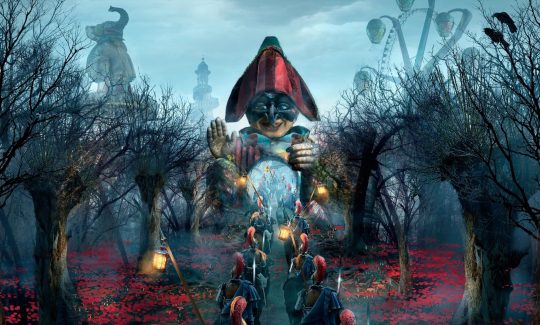
Shadowland Forest
Inspired by the Black Forest of Germany, this area features spookier attractions. West of the castle, shares the border with Mysteryland and the Gravity Falls area. There would be plenty of fir, spruce, and pine trees to make it feel like an actual forest, maybe even hide some of the attractions from view.
Snow White’s Scary Adventures : Building facade would include the Evil Queen peeking out her window.
I would place the building nearest to Storybook Town Square, at the edge of the forest.
“Gingerbread Factory Tour” : Based on my twisted Hansel and Gretel dark ride idea. Guests are given a tour of gingerbread golems at work (something like Tim Burton’s version of Wonka’s factory if it were more surreal and set in 1800s Germany), then are chased through obstacles, such as lollipop blades swinging from the walls, and peppermint stick darts, by Hansel and Gretel themselves. They’ve been very distrustful of adults after their parents abandoned them in the woods, and after the witch held them captive. They deem the guests harmless, and let them go but warn them to never come back.
Candy Carnival shop: The ride would exit into a shop themed to a candy carnival safe haven that Hansel and Gretel built for children lost in the woods. Would feature gingerbread treats and a nice selection of old-fashioned candies and German sweets. Guests can also watch bakers and candymakers at work. (Despite the name, there are no actual rides here, just animatronic decorations.)
Dragon Mountain: I wanted a unique “Mountain” ride, much like how the Matterhorn and Everest are unique to their parks. And dragons are cool.
Originally this was going to be based on Maleficent, but now I’m leaning more towards an original story. And to put a neat spin on things, instead of a fire-breathing dragon, it would be a wintery ice dragon! I would also love it if the dragon was not portrayed as a mindless, violent beast hoarding treasure, but a parent protecting their child from intruders.
I initially wanted a sub-land recreating Halloween Town (with a spooky "Scare-ousel") but I felt Fantasyland was already overrun with too many IPs (and seven carousels is enough for one park), so here an area is set aside for seasonal Nightmare Before Christmas or Villains themed events, leaving the Haunted Mansion free during the holidays.
Disney Dreamland Railroad Fantasyland station: Styled after the ruins of a medieval castle. Located on the edge of the forest near Ever After Castle, next to the entrance to Winter Village.

Wonderland
East of the castle, on the border with Create-It-Land.
While there would be plenty of natural green, there would also be an abundant mix of giant pink, purple, and turquoise “wildlife”, as seen in the initial scrapped concept art for Tokyo’s expansion. Giant mushrooms in place of benches, trees decorated with misleading signs, lamp posts that look like giant flowers.
March Hare would definitely be included as a walk-around character alongside Hatter and Alice. People often forget the tea party took place at the Hare’s and mistakenly believe Hatter to be the host, and I will not stand for this March Hare erasure.
I would also have plenty of card soldiers roaming around, “patrolling” the area.
Down the Rabbit-Hole: An upside-down funhouse with wonky mirrors, and trick doors galore! A hall of doors in the end would lead into the maze.
I was thinking there could probably also be a madhouse ride portion where guests can experience the room actually turning upside down; inspired by Villa Volta in Efteling.
Wonderland Maze: As much as I like the Alice in Wonderland ride in Anaheim, I personally feel that Wonderland is a world that is best experienced up close and at your own pace, which a maze perfectly embodies.
While the maze would obviously be themed to classic animated Alice like the Paris version, it would have different environments, like Shanghai’s Tim Burton version. First half of the maze would be a forest-like environment with giant plants and singing flowers. Second half would have rose bushes, fancy iron fences, and carved stone walls and statues for the Queen of Heart’s castle area. There would be a handful of tiny doors scattered throughout that guests can crawl through as shortcuts.
Among the character statues scattered around the maze, I really want to include the Mock-Turtle and Gryphon, based on their designs from the Jell-O commercial, perhaps on a sandy beach shore by a small fountain / pond.
House of Cards Banquet Hall: Inspired by the Queen of Hearts Banquet Hall in Tokyo. Would follow the same eccentric and colorful design scheme, but I want it to look like a stone castle made out of cards. Definitely would have lovely stained glass windows.
Desserts include Royal Heart Tarts. They could also come in souvenir cups and plates like the ones found in Tokyo.
Mad Tea Party: Would have a canopy roof to protect from the weather and direct sunlight, but I also wouldn’t mind a stained-glass version. Or even a canopy made of trees. Teacup designs would be a mix of various patterns from all versions (except Orlando’s, I do not care for the zigzag scribbles). Would also include the giant teapot with the Dormouse in the center.
To help with queue waits, I’d even have two ride systems, much like how Orlando doubled their Dumbo ride. One could even be themed to the Hatter while the other to the March Hare.
March Hare’s tea shop: Would have the same building design as March Hare Refreshments in Paris. Would sell several varieties of tea, Unbirthday Cake, and macarons.
Could also feature a long table with interactive tea things to play with, like Shanghai does at the end of its maze, and plenty of fancy chairs for photo-ops.
Mad Hatter’s hat shop: Hats, Mickey ears, and other headgear. To match the March Hare’s chimney ears, this building would resemble a large top hat.
Would also feature hat racks for photo-ops, like Shanghai does at the end of its maze.

100 Acre Wood
East of Town Square, on the border with Create-It-Land.
A tiny little area with tall trees providing shade, a lovely little Poohsticks Bridge over a small river, and a cozy corner for a meet-and-greet with Pooh and friends.
Winnie the Pooh and the Blustery Day: Basically the same as Pooh’s Hunny Hunt in Tokyo, which includes the giant book facade, and the same level of crafted detail and technical marvel throughout the ride, but with scenes added for the “rain, rain, rain”, and Pooh’s hero party as the ending. I would also use Anaheim’s zany color scheme for the Heffalumps and Woozles room with some added special effects for even more zaniness.
The ride’s name change is just to both set it apart from the other versions, and because I realized with the exception of Pooh stuck in the honey tree, all the iconic scenes in the ride come from Blustery Day.
Pooh Corner gift shop: Also utilizes the same English cottage look as Tokyo’s.
Hunny Smackerels snack stand: Hunny Pot cupcakes, honeycomb, honey ice cream, and a separate cart for honey popcorn in lovely Pooh-shaped popcorn buckets.
It would be really cute if the stand is actually inside a giant tree trunk, with a dutch door counter window for guests to order from.
The next three sub-lands would be behind Ever After Castle, outside the perimeter of the railroad tracks border. The entrance to Winter Village is between Shadowland Forest and the castle, while the entrance to Encanto Valley is between Wonderland and the castle. Mermaid Lagoon is directly behind the castle, between the other two sub-lands and only accessible through them. Small mountains would form berms for each sub-land. For reference, think of how Grizzly Gulch, Mystic Point, and Toy Story Land are arranged in Hong Kong.
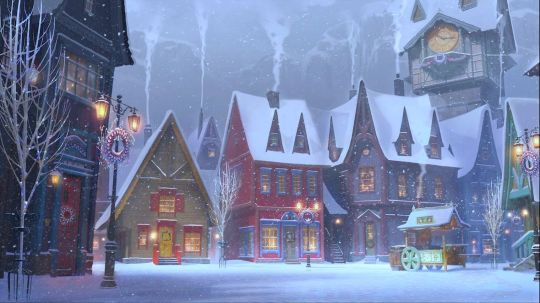
Winter Village
Inspired by my Narnia theme park concept. This entire mini-land would be indoors, to have air-conditioning to sell the illusion of winter, and to preserve the artificial winter setup from the real-life elements outdoors. This mini-land would be round (roughly) so that the glass ceiling that lets in natural light can have a hexagonal snowflake design. At night time there’d be projections of Northern Lights.
NOT Frozen themed. It’s a cute movie and all, but far overstayed its welcome before it was even released on DVD.
Village would be a mix of Russian and Scandinavian architecture.
Can be used for a Santa Claus meet-and-greet during Christmas.
Enchanted Snow Palace: The planned but never built ride based on Hans Christian Andersen’s Snow Queen. The concept art looks leagues better than the final product of Frozen Ever After.
“Winter Sleigh Ride”: Ride through winter scenery in sleighs pulled by reindeer. Technically a dark ride, since the entire subland is indoors, but feels like an outdoor ride.
"Snowball Arcade": I really wanted something to simulate snowball fights, but without the chaos and mess. Here, guests can throw snowballs at targets to win plush prizes.
"Russian cafe": Russian pastries and snacks
"Ice skating rink": Free if you bring your own skates.
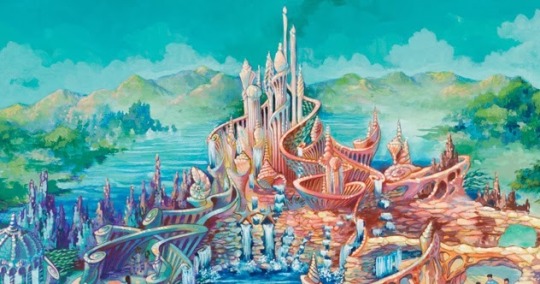
Mermaid Lagoon
A scaled-down version of the land in Tokyo DisneySea, without the playground and kiddie rides. Like DisneySea, it would have a lovely seashell castle facade, with the attractions indoors. Unlike DisneySea, there would be a small lake in front with a ship restaurant docked on it.
“Under the Sea”: NOT a retelling of the movie, but instead an original story that would take place some time pre-movie. Follows Ariel on one of her outings as she explores the sea looking for new treasures to add to her collection. Final scene could be of Ariel in her grotto after completing her latest trip, but feeling unsatisfied as she wistfully looks at her collection, while instrumentals for “Part Of Your World” softly play in the background.
King Triton’s Concert Hall: Just like the one in Tokyo DisneySea, this would be a 360 degree show with Ariel “swimming” in midair above the audience, a giant animatronic Triton, performer puppets of Flounder and Sebastian, and other mixed special effects.
Undersea Carousel: Fish carousel. Underwater lighting effects and blows bubbles as it spins.
Ariel’s Grotto gift shop
Ship restaurant: Mediterranean seafood. I mean, it’s on a human ship that’s not technically in Triton’s Kingdom, so I think this gets a pass for serving fish. It could even be themed to Chef Louis for a laugh.
“Nighttime Water Show”: Just spitballing an idea, maybe the lagoon could also be used for a nighttime water show a la Fantasmic / World of Color. The viewing area could be across the lagoon from Triton’s castle; the lights of Triton’s castle would coordinate with the show.

Encanto Valley
A lovely recreation of the valley, with Casita and a little village area for shops and Colombian dining, and plenty of lush greenery.
La Casa Madrigal: I really like @rrdcooc’s idea for Casita as a walkthrough attraction! It’s so cool! Especially the ideas for Pepa and Luisa's rooms.
I wouldn’t change much, aside from adding a few extra touches, such as an interactive flower wall in Isabela’s room that mimics guests’ silhouettes (like Daniel Rozin's "Mechanical Mirrors"), and maybe a couple themed flat rides to add capacity, such as a flowery swing spinner ride in Isabela’s room, and a tiny jungle animal carousel in Antonio’s room.
In Dolores's room, guests can see sound waves (like that Magic School Bus episode), and Camilo's room can contain "mirrors" with different character models that mimic guests' movements in real time (like VTuber avatars).
Also includes a gift shop selling “homemade” fashions and plush toys by Mirabel.
“Magic Realism Art Exhibit”: While I think the final movie is perfect, I would have loved it if Casita more closely resembled its concept art, which leaned much more heavily into magic realism. This attraction would be a walkthrough art exhibit full of giant optical illusion paintings that guests can pose in for photo-ops. For reference, I’m recalling the Trick Eye Museum, a temporary art exhibit I went to years ago in Hong Kong.
Encanto Sing-Along: I’m not always a huge fan of the “book report” shows they do in the Parks, but in this case, most of Encanto’s songs are so specific to the story that removing them from the context of the movie wouldn't work (especially in the case of fan favorite “We Don’t Talk About Bruno”).
The stage can also be used for original Colombian performances, as well as from neighboring Latin American countries.
Julieta’s Arepas: Food cart. These arepas may not heal you, but they’re magically delicious!
Arabian Oasis (scrapped)
Before Encanto was released and became one of my favorite recent movies, my initial idea was to put in an Aladdin-themed area. Not an exact recreation of Agrabah, more like a broad strokes version of Agrabah in the same manner as Arabian Coast in Tokyo DisneySea.
Magic Carpet Ride: A suspension ride in a similar manner as Peter Pan’s Flight, using the carpet vehicles. Fly through the Agrabah marketplace, over the desert, and above the clouds. Ride music features instrumentals from “A Whole New World”.
Scheherazade’s Tales From the 1001 Nights: Stage show.
Flavors of Agrabah: Arabian / Middle-Eastern cuisine
Cave of Wonders gift shop: I think the theming is appropriate considering guests are exchanging money for goods and not stealing them (ideally).
Other parts:
World Galleria
Adventureland
Mysteryland
Create-It-Land
Discoveryland
#disney parks#disney dreamland#armchair imagineering#fantasyland#alice in wonderland#winnie the pooh#little mermaid#encanto#theme park design
11 notes
·
View notes
Text

Roberto Cavalli
Italian fashion designer who used exotic animal prints, embossed leather and distressed denim to create his flamboyant clothes
As Italian fashion went global in the later 20th century, it diverged into two schools: the sensuous, soft in silhouette and touch, and the boldly sexual, flamboyant to the eye. The first, and lasting, head of the sexy school was Roberto Cavalli, who has died aged 83.
The material bases for both schools were the nation’s specialist textiles and leather firms: for Cavalli, they delivered figured and lamé leathers, garments printed after sewing so that no seams interrupted a design, and many fabrics with his emphatic prints. These featured animal-skin motifs, Renaissance and Baroque brocades, or, natural-world details derived from his digital photographs.
His aesthetic was hectic, blingy, and sold across classes and cultures: those from palazzos could don it ironically, while those for whom it was streetwear appreciated Cavalli’s celebration of blatant heterosexuality.
From the late 1990s, he expanded worldwide through clothes, shoes and accessories for women, men and children to homewares, perfume, a credit card, and cafes – in his native Florence, he bought the exclusive Caffè Giacosa and Cavalli’ed it.
He sailed the Mediterranean in his purple yacht, and was mobbed in his Manhattan store, but his emotional core locale remained Florence. His mother, Marcella, was the daughter of a painter, Giuseppe Rossi; his father, Giorgio Cavalli, a mining engineer, was shot in 1944 with 91 other civilians by German soldiers in reprisal for a partisan attack.
Postwar, Marcella scrambled by as a coal dealer, then as a dressmaker who hand painted her creations. The boy’s childhood was hard – he stuttered – but after much pleading, he studied at Florence’s Istituto d’Arte (1957-60), although never sat his final examination.
Instead, he earned money. His mother’s painted dresses inspired him to widen the idea to a mechanical process. He travelled to study Como’s many high-end textile firms, and began to print ready-to-wear sweaters for Mariuccia Mandelli of Krizia, who shared his fancy for simulated wild-beast pelts, and then for Hermès. Soon he had a studio, employees, a longed-for Ferrari and enough money to impress the banker father of Silvanella Giannoni; Cavalli claimed it was to win her hand he had achieved so much this young. They married in 1964, and had two children, Tommaso and Cristina, before divorcing in 1974.
Cavalli’s breakthrough to his own clientele came in 1969, when he gatecrashed a party for the shoe designer Mario Valentino, and mentioned to him that he could print on leather. He couldn’t, but the next day worked out a technique using supple glove kid, and returned with samples. Cavalli showed his new wares, sewn into garments, at the Paris Salon du Prêt-à-Porter in 1970. People gawped, but did not buy.
What did sell was his next inspiration. At that time, only brutal wear and laundering faded, abraded and distressed denim – the big industry that would become stone- and sand-washing, bleaching and shredding denim had not been invented – and any embellishments were crude. Cavalli ordered a container of dirty worn-out jeans from a US prison, and washed, cut and patchworked the pieces with leather and printed textiles for a collection shown in the Pitti Palace in 1972. The arte povera materials had been collaged with Italian craft skill and an artist’s eye, and appealed to the well-heeled in the last phase of Boho-hippy-rock-chick chic.
Cavalli went retail with his designs through boutiques, opening the first, Limbo, in St Tropez, and built up an international following. As a high-living celebrity, and a divorcee with loud enthusiasm for beautiful women, he was a judge at the 1977 Miss Universe pageant, where he did not vote for Miss Austria, Eva Düringer, 18, to win, as he wanted her for himself. After finishing her education, she followed him to Florence, where they married in 1980; she became his model, business manager, and mother of Robert, Rachele and Daniele. They divorced in 2010.
Cavalli retained close control of the manufacture of his clothes, proud of the skills used, and disapproved of licensing deals and production off-shoring in Italian fashion as it internationalised at the end of the 70s. He resented the 80s fashion preference for what he called “minimalism”, but was more accurately a temporary supremacy for the sensuous school, exemplified by Giorgio Armani’s unstructured tailoring for women, plus a desire to moderate overt sexiness.
The Cavalli label retained clients – rock doesn’t give up on its own – yet he stopped showing his collection, and in 1993 intended to close the factory and beg union help to re-employ its workers.
He was persuaded to a comeback show at Milan Fashion Week, and attributed his triumphant second career afterwards to his inspiration to add Lycra to denim to create stretch jeans. (Not a new idea – Irene Sharaff had denim experimentally woven with Lycra for the dancers’ jeans in West Side Story, 1961.) Cavalli personally distressed a pair, printed a snake entwining a leg, and displayed them on the perfect rear of his favourite model, Naomi Campbell.
During Cavalli’s years of retreat, Gianni Versace had taken over much of the remaining custom for Italian-originated sexiness, but Versace designs, especially his prints, had a mad Roman emperor stridency never seen in the work of Cavalli, whose leopards and tigers were for cuddling and stroking, not gladiatorial combat.
Even before Versace’s death in 1997, Cavalli was in the ascendant again, in demand on red carpets, on stage on Jennifer Lopez, Beyoncé, Christina Aguilera, and on screen – a giraffe-skin print – on Carrie Bradshaw in Sex and the City: he opened boutiques and cafes around the world for his sex-is-fun, Latin-culture-orientated, clothes that suited the mood of excess is success. He was the first Italian designer to create a collection for H&M, a sell-out in 2007. His company closed in 2014, but was relaunched a year later, with little input from Cavalli himself.
In 2002, tax police inspected Cavalli’s extravagant house and estate outside Florence, including the purple helicopter he piloted, and charged him with evasion for claiming expenses for the property as work premises rather than a private home. Cavalli was found guilty and sentenced to 14 months jail, but a superior court annulled the verdict.
A son, called Giorgio after his father, was born to his partner, Sandra Nilsson, a model, in 2023. She and his six children survive him.
🔔 Roberto Cavalli, designer, born 15 November 1940; died 12 April 2024
Daily inspiration. Discover more photos at Just for Books…?
2 notes
·
View notes
Text
Also, as someone who worked in clothing retail for ten years, it's wild how slapping a Made in Italy label on clothing will suddenly make people see it as high quality and ethically made even when it's obviously a piece of cheap shit and Italy has a problem with sweatshops where the workers are poor Chinese migrants being exploited - but people will take one look at it and be like, this is designer quality bc it's made by Italian artisans instead of incompetent Chinese workers, and it's like, this is literally Forever 21 quality and was probably made by an exploited Chinese worker in Italy, not some old master in his workshop going back to the Renaissance, come on now.
2 notes
·
View notes
Text
Adam Kimmel’s Carhartt Collections Fulfilled a Boyhood Dream

In 2011, Adam Kimmel’s first Carhartt collection debuted at Barneys New York, select other retailers nationwide, and internationally. Known for his Italian-style tailoring and relentlessly luxurious minimalist aesthetic, it seemed like Kimmel took a bit of a detour with this partnership with the stolid workwear company.
Carhartt, Inc., has offered affordable, well-made, heavy-duty pieces for more than 130 years. But what seemed like a detour was more of a full circle: Kimmel remembered wearing and loving Carhartt since childhood. So he easily found the common denominators between his high-fashion AK menswear line and what he called the “American heritage” brand: integrity, quality, and a thoroughly masculine edge.
Jay Bell, then Barneys’ vice president and merchandise manager, made the initial overtures that resulted in the collaboration. It was Bell who first saw the creative possibilities and connected Carhartt and Kimmel as a merchandising win for Barneys, as well.
Romancing an American heritage brand
This first collaboration with another clothing brand gave Kimmel, as he put it, an opportunity to “expand my business in a romantic way.” It became one in a series of thoughtfully implemented creative endeavors highlighting cultural influencers—for example, Snoop Dogg, Beat-era art magazine Semina, and “artificial realist” artist George Condo—whose distinctive styles and immediately recognizable viewpoints vibed with Kimmel’s own.
For Carhartt, this very special partnership signaled its first stateside venture into designer clothes after pairing with noted European brands. Kimmel put a lot of effort into showing Carhartt they were dealing with a fan with total respect for their product, someone whom they could trust when putting their brand in his hands.
For his Carhartt launch, Adam Kimmel created more than two dozen pieces in classic, comfortable fabrics like denim, cotton twill, moleskin, and flannel. He offered a quilted moleskin jacket, moleskin pants, a canvas artist’s coat lined with brushed cotton, and other distinctive outerwear items. There were shirts constructed from denim or flannel, and the color palette centered on the designer’s favored neutrals, as well as indigo and royal blue.
Another of the stylistic innovations for Carhartt was to switch up its classic wave-shaped logo from crimson and gold to blue and red.
Throughout, the designer focused on sleekening the cut and softening the texture of the fabrics he used. He transported the basic ethos of his AK brand, whose pieces were fashioned in Italy from the finest Italian-made fabrics, to Carhartt’s facilities in the United States.
“Honest value for an honest dollar”
These pieces mirrored the workwear themes that distinguished most of Kimmel’s collections under his own brand, but featured affordable price points starting from about $70.
He had always been impressed, Kimmel told an interviewer from Dazed Digital, with Carhartt’s “quality and durability.” The company’s thoughtfully designed extra touches, including reinforced riveting, disaster-resistant fabrics, and heavy-duty threads, extend the life and wearability of their heavy-rotation garments for years. A dozen years after his first Carhartt collection appeared, the elegantly sturdy pieces are holding their value on upscale resale clothing sites like TheRealReal.
In 1889, in Dearborn, Michigan, Hamilton Carhartt founded the company that now bears his name. His motto: “Honest value for an honest dollar.” He’d started out in furniture, but a conversation with a railroad engineer led Carhartt to realize there was a market for the kind of tough, durable work clothing that railway and other workers needed. From half a dozen staff and two sewing machines, Carhartt expanded his business thanks to the industrial build-out, in steam and steel, of a growing nation. He also dressed farmers and ranchers—anyone who needed sturdy, element-resistant pieces for working outdoors.
The very bearable lightness of being
In his second collaboration with Carhartt, Kimmel’s quirky humor—and that of his model, photographer Ari Marcopoulos—leapt off the page that recorded their “A Day in the Park” photo shoot.
Kimmel constructed these designs around the classic looks of park rangers and state troopers—two public service jobs for which he holds a lot of respect. After stopping by Kimmel’s office and putting on the iconic ranger hat he saw there, Marcopoulos became one in a long line of Kimmel friends and creative influences to serve as muse. The dark green flight coat Kimmel shaped from duck canvas fabric fit Marcopoulos with the designer’s trademark fine tailoring.
While he designed his initial Carhartt collection for Fall/Winter 2011, Kimmel was able to bring a more delicate touch to the second edition for Spring/Summer 2012. He lightened up the fabrics and gave the whole a more refined, elevated touch. To create the backdrop for the clothing, he brought in Paintallica, the “gutsy and tough” artists’ collective whose carvings adorned display windows at Barneys, among other venues. It’s that gutsy toughness that Kimmel wanted to define that season’s pieces.
Today’s Carhartt brand, still based outside of Detroit and still family-owned, continues to signify value, fitness for purpose, and style. And Adam Kimmel’s Carhartt collection—like each of his runway collections and artistic collaborations—continues to inspire passion in new fans, thanks to his precise eye for how to best infuse fashion into function.
Read the full article
2 notes
·
View notes
Text
Mods: The Progressives
Background on the 1960′s fashion world:
When you think of the 1960′s you most likely think of the fashion associated with Mods like shift dresses, mini skirts or go go boots as well as fashion icons like Twiggy, Jane Birkin or Nancy Sinatra. Between the 1950′s and 1960′s there was a transition in fashion as in the 50′s fashion was focused on French designers and was controlled around the wealthy elite. But with the new decade there was the creation of youth fashion where designers focused more on what young people were wearing. The cycle of fashion changed. It went from designers being copied by retailers to sell to consumers but they were taking inspiration from people on the streets and basing their design off of them. We also saw a shift in fashion capitals, London was fashions new muse, in particular Carnaby Street and in the Soho area in general.
Notable designers of the decade would be Mary Quant, Ossie Clark, Paco Rabanne, YSL, Givenchy and Andre Courreges to name just a few. Designers worked with man made materials to create their clothes and experimented with synthetics such as PVC and Polyester. Boutiques were made popular by Mary Quant setting up her first boutique in 1955. This was so that customers could combine items whilst still being accessible in urban environments like London.
Their seems to be a debate on who first created the mini skirt between Mary Quant and Andre Courreges when I was researching but some come to the conclusion that Andre created it whilst Quant popularised it. Breakfast at Tiffany’s was known for the black dress designed by Givenchy and created what we now know as “The Little Black Dress.” Now the most popular 60′s icons would be twiggy, Audrey Hepburn, Jean Shrimpton and Peggy Moffitt. However, people fail to mention Donyale Luna in that list, even though her impact has been important to the culture we know today. She was the first black women to appear on the cover of British Vogue and coined the first black supermodel. She also was reported as Andy Warhol’s and Salvador Dali’s muse. I recommend looking into her story.
Mods in the 1960′s:
Mods derived from the word modernists were teenagers from the baby boomer generation who’s families had benefited from the economic boom after WW2 in Britain. It was also a way to escape from the political issues that were going on at the time as they were seen as “adult problems” as it is reflected in the emphasis on being or dressing childlike as a divergence from adults. There were 3 stages of 60′s fashion. The early 60′s was the introduction of the ‘new look’ showing the new boxy silhouette that contrasts with the hourglass body type of the 50′s. Then there was the mid 60′s when the mini skirt and shift dress is introduced. In the late 60′s garments were more flowy, often associated with the hippies movement. This style was also influenced by south Asian clothing with pieces such as the Afghan coat coming from it as well as many patterns inspired from Indian clothing.
Bands like The Who, The Beatles and The Small Faces were influenced by this style as The Beatles were known for wearing skinny ties which were popular at the time. They were commonly associated with vespas as they were sleek and clean but also fast. A lot of teenagers preferred to go to coffee shops that opened late or jazz clubs. The style had evolved from their ancestors of the Teddy boys and ‘50s Betniks. Men’s style was influenced by suits from the Edwardian era as well as those of the French and Italian kind which were sharp and tailored. They also wore turtle necks and heavy jackets to survive UK winters. The women also wore clean lines and bright colours and controversial above the knee hemlines (Knees! How scandalous, How horrifying!) At the time they were seen as progressive which on reflection can seem quiet shocking for how far we have come today, even though today is far from perfect. The style to some extent was seen as quiet androgynous with women adopting short hair styles and were becoming more independent as the second wave of feminism influenced ideas of women in the 1960′s as women believed that they should build a life outside of the home. This style was quiet popular to say it was a subculture but it did also clash with the equally popular rocker crowd of the time in England.
When writing this I thought back to trends have realised that the 60′s in fashion has forever impacted culture but the mods can still be seen today in terms of trends with bright pastel colours and mini skirts being a forever staple. Although now I believe that there has grown to be subcultures but also an emphasis on personal style. There are so many icons from this decade that I wish I could all mention and explore. Not only in fashion but in music as well.
Hey guys, sorry it’s been a while, been focusing on school. I hope you are all doing well. Thank you for the love on my last post, I really appreciate it!!! Hopefully I will post more soon.
Lots of Love,
~Siren~ <3
#twiggy#60s fashion#fashion#fashion trends#fashion history#mary quant#paco rabanne#emilio pucci#nancy sinatra#jane birkin#the beatles#the who#vintage#donyale luna#historic fashion#history#london#audrey hepburn#breakfast at tiffany's#little black dress#mini skirt#shift dress#suits
14 notes
·
View notes
Text
Wholesale Women's Clothing UK - Red Wholesale
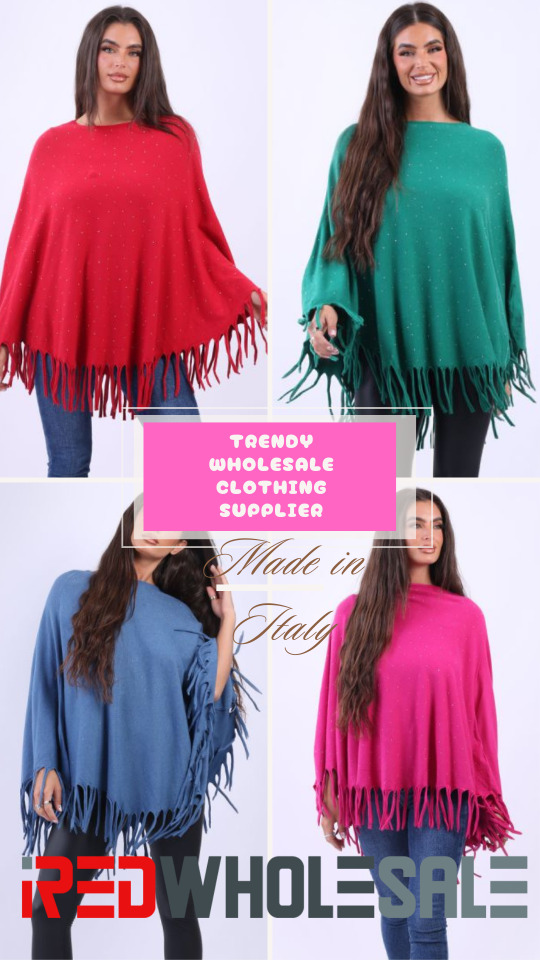
B2B Wholesale Clothing
We are a proud ladies B2B fashion wholesaler in Manchester providing superior quality Made in Italy Wholesale Womens Clothing UK to boutique owners or retailers running online stores, ranging from casual to formal in a variety of colors and sizes. Our Italian wholesale clothing is known for it’s outclass designing, fine tailoring, brilliant cuts and durability that makes it a worthwhile investment for our clients. As B2B wholesale clothing suppliers, we promise you good profit margins along with customer’s satisfaction and a great wholesale online shopping experience that would bring versatility with quality to your inventory.

Latest Wholesale Boutique Fashion
We house the finest wholesale clothing for boutiques and provide shipping across UK, USA, New Zealand and Australia. For bulk buyers, our boutique wholesale fashion ranges from stylish wholesale womens dresses, tops, trousers, outerwear, co-ords, loungewear, lagenlook wholesale clothing to various plus size wholesale outfits as well. Such diversity in womens wholesale fashion makes us one of the top wholesale clothing UK suppliers. All our efforts are meant to showcase a top-notch collection of ladies wholesale fashion clothes for boutiques, retailers and online stores at affordable wholesale prices throughout the year.
youtube
#madeinitaly#wholesale clothing#wholesaleclothesuk#madeinitalyclothing#clothingsupplier#plus size clothing#boutiquefashion#Youtube
2 notes
·
View notes
Text
History of the Star Sisters, Pt. 4
Something of a bonus interview by He-man.org user Tallstar, this time with Cathy Larson (referenced in an earlier interview I posted with Janice Varney-Hamlin). This was posted directly to the forums & is so still accessible! Cathy Larson worked on the She-Ra line as a whole, and was one of the team developing Mattel’s in-house lore (later supplemented by Filmation, specifically Larry DiTillio’s work). She’s the one who named Adora!
Cathy Larson was hired by Mattel in 1973. Through hard work and dedication, she climbed the corporate ladder and eventually secured the coveted Assistant Product Manager position, thereby making her one of the most influential employees to work on the Princess of Power toy line. She was also the Marketing Assistant on The Star Sisters extension line that was planned for release in 1987. In the early 90s, Cathy would go on to become Vice President of Marketing for Arco Toys, a Hong Kong-based division of parent company Mattel, which was acquired in 1986 and served as a letter of credit business offering low-priced, non-promoted toys primarily to U.S. retailers. The Arco Toys Division officially closed in 2000.
I started at Mattel right out of high school and realized very quickly that I wanted to work in Marketing because Mattel was a Marketing company and the bosses always had so much fun creating and advertising toy lines. But without a degree, it took me nine years and many different jobs to finally prove myself. I finally got the Assistant Product Manager job and worked for the Director of Dolls. She-Ra was the first project I really got to take a lead in.
What were some of the difficulties / "hiccups" experienced by Design and/or Marketing on the Princess of Power line?
Mattel would bring their major customers into their (then) Hawthorne, Calif offices for presentations of the new She-Ra line. This was always stressful for the Designers and Marketers because we often had to show prototypes which could be quite rough. If too rough, especially on such an innovative line ("action figures for girls") the presentation didn't go well. If the presentation didn't go well often enough, the line could get dropped before it even got a shot. One presentation to Toys R Us, we had very rough epoxy sculpts, which were very fragile. Of course, minutes before the presentation, they were dropped and many arms and legs broke off the dolls. Horrors! But the amazing design team came in and fixed them and they were presented last that day.
The Powers of Grayskull extension line for Masters of the Universe (He-Ro, Eldor et al.) was planned for release the same year as The Star Sisters. Was there any/much communication between the Girls' and Boys' departments with regard to potential crossovers, story scenarios, synchronized product releases and so on?
Not really. The boys department were worried that having girls toys associated with their line might make it too sissy for their target market. Different retail buyers... Different kids... Different advertising venues... No real reason to cross-over.
Do you know if the prototype Star Sisters figures featured in the Italian and American Mattel Toys catalogs still exist, and do you recall which employee(s) sculpted them and came up with their names?
I don't know about prototypes. They were were often quite fragile and I would be surprised if they still existed. Aldo Favilli was Mattel's head of sculpting during my time on She-Ra. He would not have sculpted them himself as he had many free-lance sculptors across the country. Aldo was a soft spoken older Italian Man, tall and slender, and with the most beautiful hands. One of my favorite people at Mattel. I can see the woman who worked on names but I'm afraid I can't pull her name up from my memory banks. She came up with fabulous She-Ra names like "Castaspella" [[note: that means it’s Justine Dantzer]]. Perfect, right? By the way, She-Ra's alter ego was "Adora". I wanted to name her Dorian (which is my daughter's name) but my boss wouldn't let me so I settled on "Adora".
Were any characters planned beyond Starla, Jewelstar, Tallstar and Glory Bird?
Probably not.
I'm interested to know if there were any abandoned features and/or accessories? What were they?
Designers and Marketers would brainstorm tons of features and accessories and only a handful would make it into the line. So there are probably a lot of sketches of "abandoned" features and/or accessories. I know Mattel would hang onto these for years for proprietary reasons (maybe forever). Have you contacted them to see if they still have them? They might share them with you.
At one time, "Lee's Action Figure News & Toy Review" magazine reported that the dolls would have come with a mini-comic entitled "Beyond the Azure Star Caverns" and Mattel had plans for a Star Caverns playset, although no evidence has ever surfaced to back up these claims. Any truth to these rumors?
Sounds feasible but I honestly don't remember the details. If the line had started to slow down, a playset would have been the first to come out of the plans. Very expensive to tool and very hard to sell to the trade.
Do you recall if The Star Sisters got far enough along in the process to have packaging ("proof cards", etc.) designed for them? If so, could you describe what it would have looked like? The 1987 Mattel Toys catalog mentions "four color window box packaging", so I'm curious to know if perhaps it would have been similar to what was released in Mexico for the first series Princess of Power figures, as opposed to the standard blister card style.
Sorry, don't remember. But, more than likely, the packaging was blister cards. [[note: the packaging was revealed at Power-Con four years after this interview & was in fact standard blister cards]]
Were there any additional story scenarios for The Star Sisters beyond what fans' know from the final issue of the She-Ra, Princess of Power magazine?
Probably not.
The Star Sisters appear for all of one minute in a single episode of the She-Ra, Princess of Power animated series, although they look very different from the prototype dolls. Had the extension line received the necessary retailer support and been successful, would there have been any plans for a spin-off series based on this line? Or would The Star Sisters have simply made more appearances on the main series?
If successful, a spinoff most certainly would have been considered.
I am curious to hear your thoughts on what you believe the factors were that led to the demise of this extension line for Princess of Power.
The demise was a simple and common reason... we shipped too many dolls and they started to back up on the shelves. Once that happens, the retailers start to mark them down... and once that happens, it's quite impossible to continue because they just won't buy any more.
10 notes
·
View notes